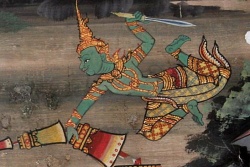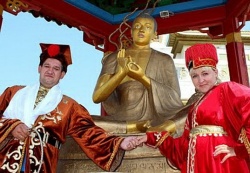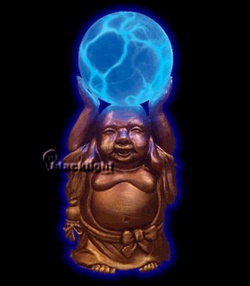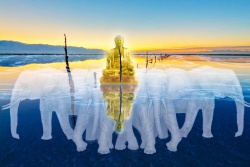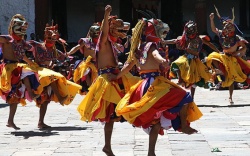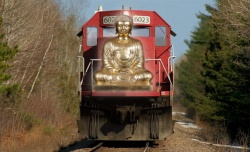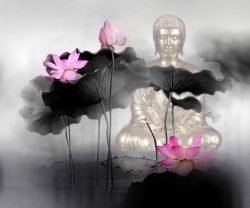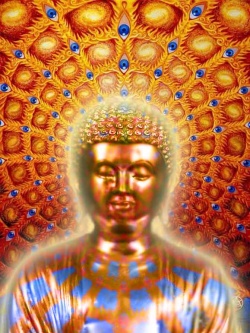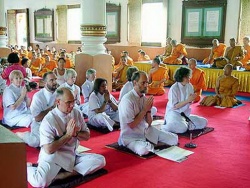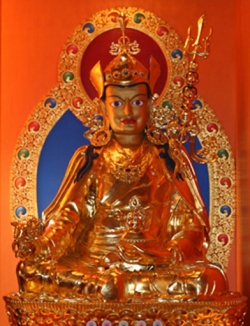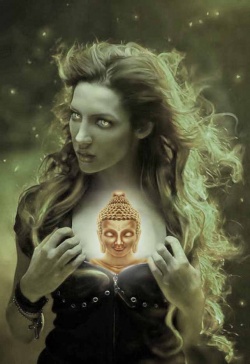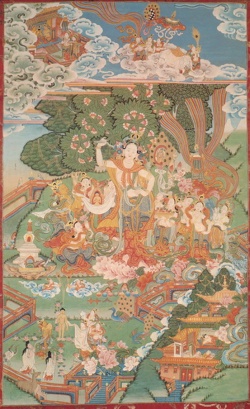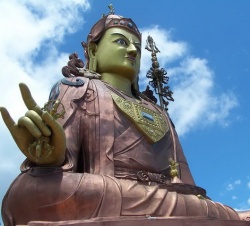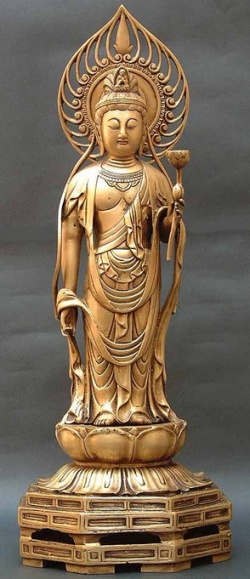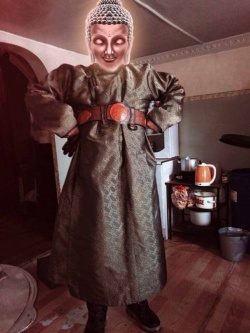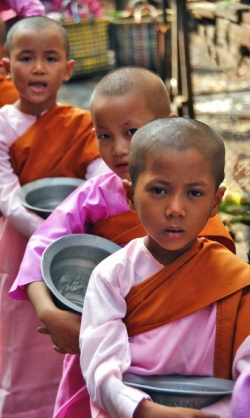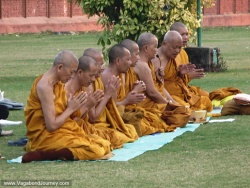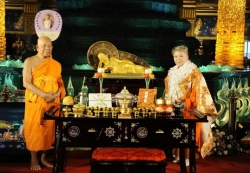Mudras In Buddhist Symbolism, Buddhist Philosophy
Mudras In Buddhist Symbolism, Buddhist PhilosophyThe Mudras are a series of symbolic or ritualistic hand gestures, describing the actions of the characters represented in only the most interesting Buddhist art. Mudras are a non-verbal mode of communication and self-expression, consisting of hand gestures and finger-postures. They are symbolic sign based finger patterns taking the place, but retaining the efficacy of the spoken word, and are used to evoke in the mind ideas symbolizing divine powers or the deities themselves. The composition of a mudra is based on certain movements of the fingers; in other words, they constitute a highly stylized form of gestureal communication. It is an external expression of 'inner resolve', suggesting that such non-verbal communications are more powerful than the spoken word.
Many such hand positions were used in the Buddhist sculpture and painting of India, Tibet, China, Korea and Japan. They indicate to the faithful in a simple way the nature and the function of the deities represented. Mudras are thus gestures which symbolize divine manifestation. They are also used by monks in their spiritual exercises of ritual meditation and concentration, and are believed to generate forces that invoke the deity.
But a mudra is used not only to illustrate and emphasize the meaning of an esoteric ritual. It also gives significance to a sculptural image, a dance movement, or a meditative pose, intensifying their potency. In its highest form, it is a magical art of symbolical gestures through which the invisible forces may operate on the earthly sphere. It is believed that the sequence itself of such ritual hand postures may have eventually contributed to the development of the mudras of Indian Classical dance.
Another interesting meaning is given to the idea of the mudra. It reveals the secret imbibed in the five fingers. In such an interpretation, each of the fingers, starting with the thumb, is identified with one of the five elements, namely the sky, wind, fire, water, and the earth. Their contact with each other symbolizes the synthesis of these elements, significant because every form in this universe is said to be composed of a unique combination of these elements. This contact between the various elements creates conditions favorable for the presence of the deity at rites performed for securing some desired object or benefit. That is, mudras induce the deity to be near the worshipper.
While there are a large number of esoteric mudras, over time Buddhist art has retained only five of them for the representations of the Buddha. Images of the Buddha which exhibit mudras other than these are extremely rare. The significance of these mudras can be gauged from the fact that each of the five transcendental Dhyan Buddhas is assigned one of these mudras, and they are invariably depicted in visual arts with this particular mudra only.
A collection of some of the Buddhist mudras are as follows:
Abhaya Mudra
The Abhaya mudra ("mudra of no-fear") represents protection, peace, generosity, and driving away of fear.
In the Theravada it is normally made with the right hand raised to the shoulder's height, the arm bent and the palm facing outward with the fingers erect and joined and the left hand hanging down on the right side in a standing position.
Abhaya mudra was in all probability used before the oncoming of Buddhism as a symbol of good intents, proposing friendship when approaching strangers.
In Gandhara Art it is witnessed when showing the action of prophesying.
The gesture was used by the Buddha when attacked by an elephant, taming it as shown in various frescoes and scripts. In Mahayana the northern schools' deities frequently put it to use with another mudra paired with the other hand.
Abhaya in Sanskrit means fearlessness. Thus this mudra symbolizes protection, peace, and the dispelling of fear. It is made with the right hand raised to shoulder height, the arm crooked, the palm of the hand facing outward, and the fingers upright and joined. The left hand hangs down at the side of the body. In Thailand, and especially in Laos, this mudra is associated with the movement of the walking Buddha (also called 'the Buddha placing his footprint'). It is nearly always used in images showing the Buddha upright, either immobile with the feet joined, or walking.
This mudra, which initially appears to be a natural gesture, was probably used from prehistoric times as a sign of good intentions - the hand raised and unarmed proposes friendship, or at least peace; since antiquity, it was also a gesture asserting power, as with the magna manus of the Roman Emperors who legislated and gave peace at the same time.
Buddhist tradition has an interesting legend behind this mudra:
Devadatta, a cousin of the Buddha, through jealousy caused a schism to be caused among the disciples of Buddha. As Devadatta's pride increased, he attempted to murder the Buddha. One of his schemes involved loosing a rampaging elephant into the Buddha's path. But as the elephant approached him, Buddha displayed the Abhaya mudra, which immediately calmed the animal. Accordingly, it indicates not only the appeasement of the senses, but also the absence of fear.
In Gandhara art, this mudra was sometimes used to indicate the action of preaching. This is also the case in China where it is very commonly found in images of the Buddha, mainly in the Wei and Sui eras (fourth to seventh centuries).
The Abhaya mudra is displayed by the fifth Dhyani Buddha, Amoghasiddhi. He is also the Lord of Karma in the Buddhist pantheon. Amoghasiddhi helps in overcoming the delusion of jealousy. By meditating on him, the delusion of jealousy is transformed into the wisdom of accomplishment. This transformation is hence the primary function of the Abhaya mudra.
But it is not just the divine Buddha who is credited with making mudras. Every position assumed and every gesture performed by our mortal body may be said to imprint its seal on the Ether, and sent forth a continuous stream of vibrations that impress the atmosphere. But to be really effective there must be a deliberate and intended arrangement of the body or parts of the body. Such an arrangement is nothing but the yoga of mudra. It is interpreted as being able to bring the physiological system in harmony with the cosmic forces and so form a magical microcosm through which the macrocosm can be represented, channelled, and utilized. The mudra in all its variations is, therefore, a traditional body pattern; an archetypal posture of performed occult significance.
We perform mudras in every action, every moment of the day. Each action is a symbol of our underlying mental and physical condition and results because of the various energy patterns forming within our being. These patterns determine our personality character and mannerism and expressions. Thus our every moment is an expression of our inner-nature. Consciously performing mudras allow us to become more aware of inner energy and to control it so that we make the most of each moment. The effect is total, at once subtle but powerful. In this way, we learn to integrate our dissipated thoughts and actions, so that life becomes a graceful flow of energy and understanding. Our whole being can then become a mudra, a gesture of life within, reflecting into our external life.
Dharmacakra Mudra
The Dharmacakra mudra represents a primal moment in the life of Buddha when he preached his first sermon after his Enlightenment, in Deer Park in Sarnath. Gautama Buddha is normally only depicted making this mudra, except Maitreya as the dispenser of the Law. The Dharmacakra Mudra position symbolises the turning of the wheel of the Dharma.
Dharmacakra mudra is created when two hands close together in front of the chest in Vitarka having the right palm forward and the left palm upward, at times facing the chest. Mudras In Buddhist Symbolism, Buddhist Philosophy
There are umpteen variants such as in the frescoes of Ajanta caves, India, where the two hands are separated and the fingers do not touch. In the Indo-Greek style of Gandhara the clenched fist of the right hand apparently overlie the fingers joined to the thumb on the left hand.
Dharmachakra mudra
Dharmachakra in Sanskrit means the 'Wheel of Dharma'. This mudra symbolizes one of the most important moments in the life of Buddha, the occasion when he preached to his companions the first sermon after his Enlightenment in the Deer Park at Sarnath. It thus denotes the setting into motion of the Wheel of the teaching of the Dharma.
In this mudra the thumb and index finger of both hands touch at their tips to form a circle. This circle represents the Wheel of Dharma, or in metaphysical terms, the union of method and wisdom. The three remaining fingers of the two hands remain extended. These fingers are themselves rich in symbolic significance.
The three extended fingers of the right hand represent the three vehicles of the Buddha's teachings, namely:
The middle finger represents the 'hearers' of the teachings
The ring finger represents the 'solitary realizers'
The Little finger represents the Mahayana or 'Great Vehicle'.
The three extended fingers of the left hand symbolize the Three Jewels of Buddhism, namely, the Buddha, the Dharma, and the Sangha. Significantly, in this mudra, the hands are held in front of the heart, symbolizing that these teachings are straight from the Buddha's heart.
This mudra is displayed by the first Dhyani Buddha Vairochana. Each of the five Dhyani Buddhas is associated with a specific human delusion, and it is believed that they help mortal beings in overcoming them. Thus, Vairochana is believed to transform the delusion of ignorance into the wisdom of reality. By displaying the Dharmachakra mudra, he thus helps adepts in bringing about this transition.
Dhyana Mudra
The Dhyana mudra ("meditation mudra") is the gesture of meditation, of the concentration of the Good Law and the sangha.
The two hands are stationed on the lap, right hand on left hand, with fingers wholly unfolded and the palms facing upwards, shaping a triangle, emblematical of the spiritual fire or the Triratna, the three gems.
This mudra is used in representations of the Sakyamuni Buddha and Amitabha Buddha.
Sometimes the Dhyana mudra is used in particular representations of Bhaisajyaguru as the Medicine Buddha, with a medicine bowl placed on the hands. It originated in India most probably in Gandhara.
This mudra has been in use long before the Buddha, as yogis have used it during their concentration, healing, and meditation exercises. Dhyana mudra is also known as Samadhi mudra or Yoga mudra.
The Dhyana mudra may be made with one or both hands. When made with a single hand the left one is placed in the lap, while the right may be engaged elsewhere. The left hand making the Dhyana mudra in such cases symbolizes the female left-hand principle of wisdom. Ritual objects such as a text, or more commonly an alms bowl symbolizing renunciation, may be placed in the open palm of this left hand.
When made with both hands, the hands are generally held at the level of the stomach or on the thighs. The right hand is placed above the left, with the palms facing upwards, and the fingers extended. In some cases the thumbs of the two hands may touch at the tips, thus forming a mystic triangle. The esoteric sects obviously attribute to this triangle a multitude of meanings, the most important being the identification with the mystic fire that consumes all impurities. This triangle is also said to represent the Three Jewels of Buddhism, mentioned above, namely the Buddha himself, the Good Law and the Sangha.
The Dhyana mudra is the mudra of meditation, of concentration on the Good law, and of the attainment of spiritual perfection. According to tradition, this mudra derives from the one assumed by the Buddha when meditating under the pipal tree before his Enlightenment. This gesture was also adopted since time immemorial, by yogis during their meditation and concentration exercises. It indicates the perfect balance of thought, rest of the senses, and tranquillity.
This mudra is displayed by the fourth Dhyani Buddha Amitabha, also known as Amitayus. By meditating on him, the delusion of attachment becomes the wisdom of discernment. The Dhyana mudra helps mortals achieve this transformation.
Varada Mudra
The Varada mudra ("favourable mudra") connotes offering, welcome, charity, giving, concern and sincerity. It is almost always used with the left hand for those who dedicate oneself to human salvation.
It can be made with the arm crooked, the palm slightly turned up or in case of the arm facing down, the palm presented with the fingers erect or slightly bent. The Varada mudra is seldom seen without using another mudra used by the right hand, characteristically with the Abhaya mudra.
It is much mixed up with the Vitarka mudra, which it closely resembles Mudras In Buddhist Symbolism, Buddhist Philosophy.
In India the mudra is used in images of Avalokitesvara from the Gupta Period of the 4th and 5th centuries. The Varada mudra is used in a widespread manner in the statues of Southeast Asia.
Mudras of the Great Buddha: Symbolic Gestures and Postures
Mudras are a non-verbal mode of communication and self-expression, consisting of hand gestures and finger-postures. They are symbolic sign based finger patterns taking the place, but retaining the efficacy of the spoken word, and are used to evoke in the mind ideas symbolizing divine powers or the deities themselves. The composition of a mudra is based on certain movements of the fingers; in other words, they constitute a highly stylized form of gestureal communication. It is an external expression of 'inner resolve', suggesting that such non-verbal communications are more powerful than the spoken word.
Many such hand positions were used in the Buddhist sculpture and painting of India, Tibet, China, Korea and Japan. They indicate to the faithful in a simple way the nature and the function of the deities represented. Mudras are thus gestures which symbolize divine manifestation. They are also used by monks in their spiritual exercises of ritual meditation and concentration, and are believed to generate forces that invoke the deity.
But a mudra is used not only to illustrate and emphasize the meaning of an esoteric ritual. It also gives significance to a sculptural image, a dance movement, or a meditative pose, intensifying their potency. In its highest form, it is a magical art of symbolical gestures through which the invisible forces may operate on the earthly sphere. It is believed that the sequence itself of such ritual hand postures may have eventually contributed to the development of the mudras of Indian Classical dance.
Another interesting meaning is given to the idea of the mudra. It reveals the secret imbibed in the five fingers. In such an interpretation, each of the fingers, starting with the thumb, is identified with one of the five elements, namely the sky, wind, fire, water, and the earth. Their contact with each other symbolizes the synthesis of these elements, significant because every form in this universe is said to be composed of a unique combination of these elements. This contact between the various elements creates conditions favorable for the presence of the deity at rites performed for securing some desired object or benefit. That is, mudras induce the deity to be near the worshipper.
While there are a large number of esoteric mudras, over time Buddhist art has retained only five of them for the representations of the Buddha. Images of the Buddha which exhibit mudras other than these are extremely rare. The significance of these mudras can be gauged from the fact that each of the five transcendental (Dhyani) Buddhas is assigned one of these mudras, and they are invariably depicted in visual arts with this particular mudra only.
These five mudras are:
1. Dharmachakra mudra
Dharmachakra in Sanskrit means the 'Wheel of Dharma'. This mudra symbolizes one of the most important moments in the life of Buddha, the occasion when he preached to his companions the first sermon after his Enlightenment in the Deer Park at Sarnath. It thus denotes the setting into motion of the Wheel of the teaching of the Dharma.
In this mudra the thumb and index finger of both hands touch at their tips to form a circle. This circle represents the Wheel of Dharma, or in metaphysical terms, the union of method and wisdom. The three remaining fingers of the two hands remain extended. These fingers are themselves rich in symbolic significance.
The three extended fingers of the right hand represent the three vehicles of the Buddha's teachings, namely:
The middle finger represents the 'hearers' of the teachings
The ring finger represents the 'solitary realizers'
The Little finger represents the Mahayana or 'Great Vehicle'.
The three extended fingers of the left hand symbolize the Three Jewels of Buddhism, namely, the Buddha, the Dharma, and the Sangha. Significantly, in this mudra, the hands are held in front of the heart, symbolizing that these teachings are straight from the Buddha's heart.
This mudra is displayed by the first Dhyani Buddha Vairochana. Each of the five Dhyani Buddhas is associated with a specific human delusion, and it is believed that they help mortal beings in overcoming them. Thus, Vairochana is believed to transform the delusion of ignorance into the wisdom of reality. By displaying the Dharmachakra mudra, he thus helps adepts in bringing about this transition.
2. Bhumisparsha mudra
Literally Bhumisparsha translates into 'touching the earth'. It is more commonly known as the 'earth witness' mudra. This mudra, formed with all five fingers of the right hand extended to touch the ground, symbolizes the Buddha's enlightenment under the bodhi tree, when he summoned the earth goddess, Sthavara, to bear witness to his attainment of enlightenment. The right hand, placed upon the right knee in earth-pressing mudra, and complemented by the left hand-which is held flat in the lap in the dhyana mudra of meditation, symbolizes the union of method and wisdom, samasara and nirvana, and also the realizations of the conventional and ultimate truths. It is in this posture that Shakyamuni overcame the obstructions of Mara while meditating on Truth.
The second Dhyani Buddha Akshobhya is depicted in this mudra. He is believed to transform the delusion of anger into mirror-like wisdom. It is this metamorphosis that the Bhumisparsha mudra helps in bringing about.
3. Varada mudra
This mudra symbolizes charity, compassion and boon-granting. It is the mudra of the accomplishment of the wish to devote oneself to human salvation. It is nearly always made with the left hand, and can be made with the arm hanging naturally at the side of the body, the palm of the open hand facing forward, and the fingers extended.
The five extended fingers in this mudra symbolize the following five perfections:
Generosity
Morality
Patience
Effort
Meditative concentration
This mudra is rarely used alone, but usually in combination with another made with the right hand, often the Abhaya mudra (described below). This combination of Abhaya and Varada mudras is called Segan Semui-in or Yogan Semui-in in Japan. Ratnasambhava, the third Dhyani Buddha displays this mudra. Under his spiritual guidance, the delusion of pride becomes the wisdom of sameness. The Varada mudra is the key to this transformation.
Vajra Mudra
The Vajra mudra ("thunder mudra") is the gesture of knowledge.
It is formed by making a fist with the right hand, index stretching upward, and the left hand also making a fist and enveloping the index.
A good instance of the application of the Vajra mudra is the seventh technique (out of nine) of the Nine Syllable Seals, using the mudra with mantras in a ritualistic application.
Bhumisparsa Mudra
The Bhumisparsa mudra ("earth-touching mudra") literally represents the Buddha as taking the earth as witness.
It represents the moment when Buddha took the earth as evidence when he had settled the problem of cessation of suffering when he was under the peepal tree at Bodh-Gaya.
Bhumisparsa mudra is generally represented by the historical Buddha and Aksobhya (in Vajrayana Buddhism aksobhya is one of the Five Wisdom Buddhas, a product of the Adibuddha, who represents consciousness as an aspect of reality) sitting in the lotus position.
The right hand touches the ground with the fingertips near the right knee stretched, or with only the index finger pointing down touching the ground with the left hand normally resting on the lap with the palm facing up.
The mudra can also represent the vanquishing of the demon horde of Mara. Aksobhya is frequently seen using this mudra while clasping part of his robe with his left hand.
Literally Bhumisparsha translates into 'touching the earth'. It is more commonly known as the 'earth witness' mudra. This mudra, formed with all five fingers of the right hand extended to touch the ground, symbolizes the Buddha's enlightenment under the bodhi tree, when he summoned the earth goddess, Sthavara, to bear witness to his attainment of enlightenment.
The right hand, placed upon the right knee in earth-pressing mudra, and complemented by the left hand-which is held flat in the lap in the dhyana mudra of meditation, symbolizes the union of method and wisdom, samasara and nirvana, and also the realizations of the conventional and ultimate truths. It is in this posture that Shakyamuni overcame the obstructions of Mara while meditating on Truth.
The second Dhyani Buddha Akshobhya is depicted in this mudra. He is believed to transform the delusion of anger into mirror-like wisdom. It is this metamorphosis that the Bhumisparsha mudra helps in bringing about.
Vitarka Mudra
The Vitarka mudra ("mudra of discussion") is the gesture of discussion and transmission of Buddhist doctrines.
Mudras In Buddhist Symbolism, Buddhist Philosophy It is done by joining the tips of the thumb and the index together, and keeping the other fingers straight, very much like Abhaya and Varada mudras, but with the thumbs touching the index fingers.
This mudra has a great number of variances in Mahayana Buddhism in East Asia. Vitarka mudra is also known as Prajnalinganabhinaya, Vyakhyana mudra ("mudra of explanation");
Vitarka mudra is interpreted as the hand gesture that evokes the energy of teaching and intellectual discussion, or argument. It mostly feels like the transmission of a particular teaching with no words, and the circle formed by the thumb and index finger creates a constant flow of energy/information.The Vitarka mudra is done by joining the tips of the thumb and the index together, and keeping the other fingers straight very much like Abhaya and Varada mudra but with the thumbs touching the index fingers.
The Vitarka mudra has a great number of variants in Mahayana Buddhism in East Asia. In Tibet it is the mystic gesture of Taras and Bodhisattvas with some differences by the deities in Yab-yum. (Vitarka mudra is also known as Prajnalinganabhinaya or Vyakhyana mudra (mudra of explanation).
Jnana Mudra
The Jnana mudra ("mudra of knowledge") is formed by touching the tips of the thumb and the index together, establishing a circle, the hand is held with the palm inward toward the heart.
Karana Mudra
The Karana Mudra routs out demons and removes hindrances like sickness or negative thoughts.
It is made by raising the index and the little finger, and folding the other fingers. This mudra is also known as Tarjana mudra.
